This article needs additional citations for verification .(April 2017) |
The static buoyancy of airships in flight is not constant. It is therefore necessary to control the altitude of an airship by controlling its buoyancy: buoyancy compensation.
This article needs additional citations for verification .(April 2017) |
The static buoyancy of airships in flight is not constant. It is therefore necessary to control the altitude of an airship by controlling its buoyancy: buoyancy compensation.
For example, on a flight from Friedrichshafen to Lakehurst, the rigid airship LZ 126, built in 1923-24, used 23,000 kg gasoline and 1300 kg of oil (an average consumption of 290 kg/100 km). During the landing the airship had to release approximately 24,000 cubic meters of hydrogen to balance the ship before landing it. A Zeppelin of the size of the LZ 129 Hindenburg on a flight from Frankfurt am Main to Lakehurst consumed approximately 54 tonnes of diesel with a buoyancy equivalent of 48,000 cubic metres of hydrogen, which amounted to about a quarter of the lifting gas used at the start of the flight (200,000 cubic metres). After the landing, the jettisoned hydrogen was replaced with new hydrogen.
The Zeppelin NT has no special facilities to offset the extra buoyancy by fuel consumption. Compensation takes place by using a start-weight that is higher than the buoyancy lifting level at the start and during the flight, the extra dynamic buoyancy needed for lift-off and flight is produced with engines. If, during the trip, the ship becomes lighter than air because of fuel consumption, the swivel engines are used for down pressure and landing. The relatively small size of the Zeppelin NT and a range of only 900 kilometers compared to the historical Zeppelins allowed the waiver of a ballast extraction device.
With a rigid airship two main strategies are pursued to avoid the venting of lifting gas:
Only gasses have a density similar or equal to air.
Different attempts were made on hydrogen airships: the LZ 127 and LZ 129 to use part of the lifting gas as a propellant without much success, later ships filled with helium lacked this option.
Around 1905, Blau gas was a common propellant for airships; it is named after its inventor the Augsburger chemist Hermann Blau who produced it in the Augsburger Blau gas plant. Various sources mention a mixture of propane and butane. Its density was 9% heavier than air. Zeppelins often used a different gas mixture of propylene, methane, butane, acetylene (ethyne), butylene and hydrogen. [3]
The LZ 127 Graf Zeppelin had bi-fuel engines, and could use gasoline and Blau gas as a propellant. Twelve of the vessel's gas cells were filled with a propellant gas instead of lifting gas with a total volume of 30,000 cubic metres, enough for approximately 100 flight hours. The fuel tank had a gasoline volume of 67 flight hours. Using both gasoline and Blau gas, one could achieve 118 hours of cruise time.
In some airships rain gutters were fitted to the hull to collect rainwater to fill the ballast water tanks during flight. However, this procedure is weather dependent and is therefore not reliable as a standalone measure.
Captain Ernst A. Lehmann described how during World War I Zeppelins could temporarily remain at the sea surface by loading ballast water into tanks in the gondolas. [4] In 1921 the airships LZ 120 "Bodensee" and LZ 121 "Nordstern" tested the possibility on Lake Constance to use lake water to create ballast. These attempts, however, showed no satisfactory results.
The silica gel method was tested on the LZ 129 to extract water from the humid air to increase weight. The project was terminated.[ citation needed ]

The most promising procedure for ballast extraction during the journey is condensation of the engines' exhaust gasses, which consist mainly of water vapour and carbon dioxide. The main factors affecting gainable water are the hydrogen content of the fuel and humidity. The necessary exhaust gas coolers for this method had repeated problems with corrosion in the early years.
The first trials on the DELAG-Zeppelin LZ 13 Hansa (1912–1916) were conducted by Wilhelm Maybach. The trials were not satisfactory, resulting in the project's termination.
The USS Shenandoah (ZR-1) (1923–25) was the first airship with ballast water recovered from the condensation of exhaust gas. Prominent vertical slots in the airship's hull acted as exhaust condensers. A similar system was used on her sister ship, USS Akron (ZRS-4) . The German-made USS Los Angeles (ZR-3) was also fitted with exhaust gas coolers to prevent jettisoning of the costly helium.
Changes in the lifting gas temperature in relation to the surrounding air have an effect on the buoyancy balance: higher temperatures increase buoyancy; lower temperatures decrease buoyancy. Artificially changing the lifting gas temperature requires constant work as the gas is barely thermally isolated from the surrounding air. However, it was common to make use of natural differences in temperature such as thermal updrafts and clouds.
Preheated lifting gas was tested to offset the higher weight of the Zeppelin. One variation tested on the LZ 127 Graf Zeppelin was to blow heated air on the lifting gas storage cells with the aim to gain buoyancy for launch.[ citation needed ]
It is possible to change the density of a volume of lifting gas by compressing it with a Ballonet. Basically a balloon inside a balloon that can be pumped full of outside air from the surrounding atmosphere.

A Zeppelin is a type of rigid airship named after the German inventor Ferdinand von Zeppelin who pioneered rigid airship development at the beginning of the 20th century. Zeppelin's notions were first formulated in 1874 and developed in detail in 1893. They were patented in Germany in 1895 and in the United States in 1899. After the outstanding success of the Zeppelin design, the word zeppelin came to be commonly used to refer to all rigid airships. Zeppelins were first flown commercially in 1910 by Deutsche Luftschiffahrts-AG (DELAG), the world's first airline in revenue service. By mid-1914, DELAG had carried over 10,000 fare-paying passengers on over 1,500 flights. During World War I, the German military made extensive use of Zeppelins as bombers and as scouts, resulting in over 500 deaths in bombing raids in Britain.

LZ 129 Hindenburg was a German commercial passenger-carrying rigid airship, the lead ship of the Hindenburg class, the longest class of flying machine and the largest airship by envelope volume. It was designed and built by the Zeppelin Company on the shores of Lake Constance in Friedrichshafen, Germany, and was operated by the German Zeppelin Airline Company. It was named after Field Marshal Paul von Hindenburg, who was President of Germany from 1925 until his death in 1934.

An airship or dirigible balloon is a type of aerostat or lighter-than-air aircraft that can navigate through the air under its own power. Aerostats gain their lift from a lifting gas that is less dense than the surrounding air.
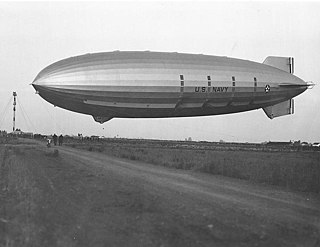
USS Akron (ZRS-4) was a helium-filled rigid airship of the U.S. Navy, the lead ship of her class, which operated between September 1931 and April 1933. It was the world's first purpose-built flying aircraft carrier, carrying F9C Sparrowhawk fighter planes, which could be launched and recovered while it was in flight. With an overall length of 785 ft (239 m), Akron and her sister ship Macon were among the largest flying objects ever built. Although LZ 129 Hindenburg and LZ 130 Graf Zeppelin II were some 18 ft (5.5 m) longer and slightly more voluminous, the two German airships were filled with hydrogen, and so the two US Navy craft still hold the world record for the largest helium-filled airships.
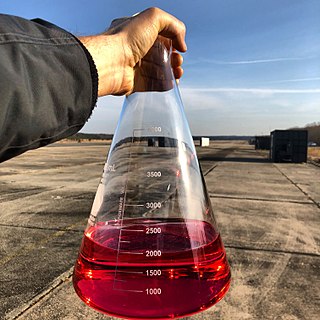
RP-1 (alternatively, Rocket Propellant-1 or Refined Petroleum-1) is a highly refined form of kerosene outwardly similar to jet fuel, used as rocket fuel. RP-1 provides a lower specific impulse than liquid hydrogen (LH2), but is cheaper, is stable at room temperature, and presents a lower explosion hazard. RP-1 is far denser than LH2, giving it a higher energy density (though its specific energy is lower). RP-1 also has a fraction of the toxicity and carcinogenic hazards of hydrazine, another room-temperature liquid fuel.

USS Los Angeles was a rigid airship, designated ZR-3, which was built in 1923–1924 by the Zeppelin company in Friedrichshafen, Germany, as war reparations. It was delivered to the United States Navy in October 1924 and after being used mainly for experimental work, particularly in the development of the American parasite fighter program, was decommissioned in 1932.

LZ 127 Graf Zeppelin was a German passenger-carrying hydrogen-filled rigid airship that flew from 1928 to 1937. It offered the first commercial transatlantic passenger flight service. The ship was named after the German airship pioneer Ferdinand von Zeppelin, a count in the German nobility. It was conceived and operated by Hugo Eckener, the chairman of Luftschiffbau Zeppelin.

The Zeppelin NT is a class of helium-filled airships being manufactured since the 1990s by the German company Zeppelin Luftschifftechnik GmbH (ZLT) in Friedrichshafen. The initial model is the N07. The company considers itself the successor of the companies founded by Ferdinand von Zeppelin which constructed and operated the very successful Zeppelin airships in the first third of the 20th century. There are, however, a number of notable differences between the Zeppelin NT and original Zeppelins as well as between the Zeppelin NT and usual non-rigid airships known as blimps. The Zeppelin NT is classified as a semi-rigid airship.

An aerostat is a lighter-than-air aircraft that gains its lift through the use of a buoyant gas. Aerostats include unpowered balloons and powered airships. A balloon may be free-flying or tethered. The average density of the craft is lower than the density of atmospheric air, because its main component is one or more gasbags, a lightweight skin containing a lifting gas to provide buoyancy, to which other components such as a gondola containing equipment or people are attached. Especially with airships, the gasbags are often protected by an outer envelope.
The highest specific impulse chemical rockets use liquid propellants. They can consist of a single chemical or a mix of two chemicals, called bipropellants. Bipropellants can further be divided into two categories; hypergolic propellants, which ignite when the fuel and oxidizer make contact, and non-hypergolic propellants which require an ignition source.
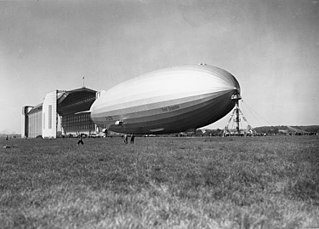
The Graf Zeppelin was the last of the German rigid airships built by Zeppelin Luftschiffbau during the period between the World Wars, the second and final ship of the Hindenburg class, and the second zeppelin to carry the name "Graf Zeppelin" and thus often referred to as Graf Zeppelin II. Due to the United States refusal to export helium to Germany, the Graf Zeppelin II was filled with hydrogen and therefore never carried commercial passengers. It made 30 flights over 11 months in 1938–39, many being propaganda publicity flights; but staff of the Reich Air Ministry were aboard to conduct radio surveillance and measurements. The airship, along with its LZ 127 namesake were both scrapped in April 1940, and their duralumin framework salvaged to build aircraft for the Luftwaffe.

A thermal airship is an airship that generates buoyancy by heating air in a large chamber or envelope. The lower density of interior hot air compared to cool ambient air causes an upward force on the envelope. This is very similar to a hot air balloon, with the notable exception that an airship has a powered means of propulsion, whilst a hot air balloon relies on winds for navigation. An airship that uses steam would also qualify as a thermal airship.
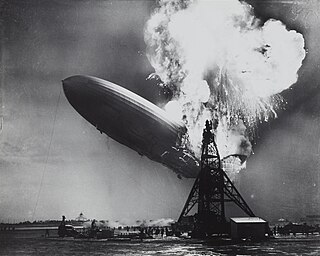
The Hindenburg disaster was an airship accident that occurred on May 6, 1937, in Manchester Township, New Jersey. The LZ 129 Hindenburg was a German commercial passenger-carrying rigid airship, the lead ship of the Hindenburg class, the longest class of flying machine and the largest airship by envelope volume. It was designed and built by the Zeppelin Company and was operated by the German Zeppelin Airline Company. It was named after Field Marshal Paul von Hindenburg, who was President of Germany from 1925 until his death in 1934. It caught fire and was destroyed during its attempt to dock with its mooring mast at Naval Air Station Lakehurst. The accident caused 35 fatalities from the 97 people on board, and an additional fatality on the ground.
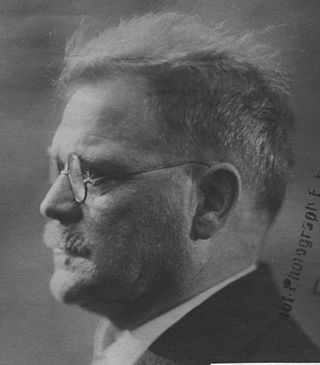
Blau gas is an artificial illuminating gas, similar to propane, named after its inventor, Hermann Blau of Augsburg, Germany. Rarely used or produced today, it was manufactured by decomposing mineral oils in retorts by heat, and compressing the resulting naphtha until it liquefied. It was transported in liquid condition, and, like LPG, when released returns to a gaseous state.

The two Hindenburg-class airships were hydrogen-filled, passenger-carrying rigid airships built in Germany in the 1930s and named in honor of Paul von Hindenburg. They were the last such aircraft to be constructed, and in terms of their length, height, and volume, the largest aircraft ever built. During the 1930s, airships like the Hindenburg class were widely considered the future of air travel, and the lead ship of the class, LZ 129 Hindenburg, established a regular transatlantic service. The airship's destruction in a highly publicized accident was the end of these expectations. The second ship, LZ 130 Graf Zeppelin, was never operated on a regular passenger service, and was scrapped in 1940 along with its namesake predecessor, the LZ 127 Graf Zeppelin, by order of Hermann Göring.
A lifting gas or lighter-than-air gas is a gas that has a density lower than normal atmospheric gases and rises above them as a result. It is required for aerostats to create buoyancy, particularly in lighter-than-air aircraft, which include free balloons, moored balloons, and airships. Only certain lighter than air gases are suitable as lifting gases. Dry air has a density of about 1.29 g/L at standard conditions for temperature and pressure (STP) and an average molecular mass of 28.97 g/mol, and so lighter-than-air gases have a density lower than this.

Hermann Blau was a German engineer and chemist, and inventor of Blau gas.

The ZeppelinLZ 4 was a German experimental airship constructed under the direction of Ferdinand von Zeppelin. First flown on 20 June 1908, it made a series of successful flights including a 12-hour flight over Switzerland. It was destroyed when it caught fire after landing to carry out engine repairs during a projected 24-hour endurance trial. This disaster proved fortunate for Zeppelin: donations by the German public raised 6.5 million marks, so guaranteeing the future of his development of airships.

The Zeppelin R Class was a type of rigid airship developed by Zeppelin Luftschiffbau in 1916 for use by the Imperial German Navy and the German Army for bombing and naval patrol work. Introduced in July 1916 at a time when British air defences were becoming increasingly capable, several were lost in the first months of operation, leading the Germans to reconsider their technical requirements and eventually to develop airships capable of bombing from a greater height. Most surviving examples were modified to meet these requirements, by reducing weight at the expense of performance. A total of 17 were built.
Aircraft engine performance refers to factors including thrust or shaft power for fuel consumed, weight, cost, outside dimensions and life. It includes meeting regulated environmental limits which apply to emissions of noise and chemical pollutants, and regulated safety aspects which require a design that can safely tolerate environmental hazards such as birds, rain, hail and icing conditions. It is the end product that an engine company sells.